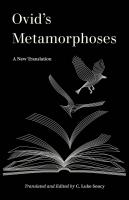
University Of California Press (2023) p/b 663pp £14.99 (ISBN 9780520394858)
Ovid (43 BC-c.AD 17) built his popularity in Augustan Rome as the author of love-making manuals composed in elegiac couplets. In the Metamorphoses (‘Transformations’) he turned to dactylic hexameters, the metre of epic, in presenting nearly 250 mythological stories. A frequent theme was the rape of young girls by sex-hungry gods, and their subsequent transformation into birds, trees or stars. Chione (11.301) is fourteen years old when she is raped by Apollo and Mercury. Her punishment is to be shot through the tongue by Diana, while her grief-stricken father flies heavenward as a hawk.
Ovid’s subject-matter did not endear him to Augustus. The regime had introduced moral legislation in 18 BC and introduced strict penalties for adultery. As Ovid finalised his subversive text in about AD 8, his chickens came home to roost and he was sent into exile. Later, the Metamorphoses became a definitive source of Greco-Roman mythology in literature and the arts.
S. is one of several scholars to have translated the work in recent years. Wisely, he has chosen iambic pentameters in preference to the bumpy pseudo-Latin dactyls of the Penguin edition. He uses heightened language and employs archaisms to good effect, referring back, like Ovid, to an earlier literary tradition: ‘Then, from its mother’s womb untimely ripped’ (3.310) or ‘To moo and walk in beauty through the grass’ (2.851).
A test for any translator is how to convey the story of Echo and Narcissus in a way that strikes a chord with English readers. In a passage beloved by classical examiners, S. goes beyond the literal: ‘Tricked by the mirrored voice, he stood and cried, / “I want you to come here!” And Echo made / The gladdest of replies: “I want you, too! / Come? Here!” (3.385-8). Later, Narcissus stares at his image in a pool; ‘cunctaque miratur quibus est mirabilis ipse’ becomes ‘Admiring all that all admire in him’ (3.424). ‘roganda / non rapienda’ (5.416) is stylishly rendered as ‘You need rapport, not rape!’ Juno’s ‘aut ego fallor, / aut ego laedor’ becomes ‘I’m either wrong or wronged’ (1.607-8).
S. can be robust. His Envy is ‘A creature pale of cheek and lean of frame, / With eyes askew and teeth grown green with mold’ (2.775-6). He can be lyrical: ‘And where once graceful goats had grazed the grass, / Misshapen seals now find a place to rest. / Nymphs gape at human groves and towns and homes, / And, in the forests, dolphins roam the oaks’ (1.299-302).
S. uses the same number of lines as Ovid’s original. This compression contributes to vigour and pace, but occasional loss of clarity. ‘Pallas once / Locked Erichthonius, whom no mother bore, / Within a chest of Attic reeds she gave / To those three maidens two-formed Cecrops sired’ (2.553-5) omits two relative pronouns and blurs the meaning. Clarity is compromised in ‘Of Doris and her daughters, some group swims’ (2.11) and in ‘Next, weightless fire / Leapt up and claimed its place in vaulting heaven, / With air beneath, the next by lightness placed’ (1.26-28). ‘corpus tumet omne veneno’, describing Mars’s dragon, becomes ‘a body bulging banes’ (3.33). The passive verb is awkward in ‘There Tityos lends his innards to bestrew / Nine acres; there you, Tantalus are fled / By stream and hanging tree’ (4.457-9).
S.’s risky use of language is offset by a strong poetic instinct. The Hours lead out Titan’s steeds ‘spewing fire, ambrosia-gorged – / And swiftly strapped their halters with a clank’ (2.120-1). His description of frogs leaves the Latin behind: ‘Their ribbits make each rib itself bulge out / As swearing stretches wide their gaping mouths; / Save neckless-seeming heads on backs of green, / Their body’s mostly belly, white and broad’ (6.377-80).
There are infelicities. For example, S. translates ‘ignarus’ as ‘clueless’, not always appropriately. ‘Sticking shaft’ is uncomfortable for ‘fixum hastile’ (3.69). ‘Running beam’ is questionable for ‘longa trabe’ (3.78); the dragon is hauling himself upright. In ‘ludit, et aut violas aut candida lilia cepit’ (5.392), ‘Played, picking lilies, or else violets’ would be better as ‘Played, picking white lilies or violets’. ‘fer opem’ (5.618) would be better as ‘Help me!’ than ‘Bring aid!’. Calliope, ‘e nobis maxima’ (5.662), is the ‘oldest’, not the ‘foremost’ of the Muses. ‘The goddess caved’ (12.32) sits unhappily for ‘victa dea est’, as does the final half-line of ‘The thousand ships, with wind astern / And much behind’ for ‘accipiunt ventos a tergo mille carinae, / multaque perpessae’ (12.37-8). In ‘Their twofold lines of hearty hearts moved on’ (11.462), S. appears to misread ‘pectora’; the rowers are pulling their oars back towards their chests.
The book concludes with a commentary, text and translation notes, a selected bibliography and a glossary of proper names. The commentary, referenced by daggers in the text, contains a brief explanation of each story with observations on myth, geography and social and religious context. The text and translation notes comment on the manuscript tradition and explain how the chosen readings have influenced S.’s translation.
S.’s translation has great merit. It is more poetic than any current version. A second edition with a helpful editor would give him the opportunity to iron out the infelicities and create a true classic.
Stuart Lyons
